The
Walther Company
Historic Recollections
by
Ray Mackay
RECOLLECTIONS CONCERNING CARL WALTHER’S COMPANY AND ITS MECHANICAL CALCULATOR PRODUCTS |
| Carl Walther Company, of Germany came in to existence in circa 1886 and in 1903 began the production of fire arms for hunting and target practice. To put this in perspective for our American friends this was the year that France erected the Statue of Liberty in New York as a gift. In 1908 with a labour force of around fifteen Fritz Walther designed the first WALTHER automatic Pocket pistol. The fire arm products became renowned by sporting groups as the byword for precision and reliability. The great depression in 1923 saw a company under great stress for even a box of matches sold for 1 billion marks. In spite of difficulties the Walther Company managed to start again. |
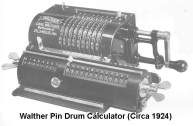 By 1924 the
Company looking towards new products to assist its
recovery commenced making calculating machines based on
the pin drum mechanism. A method by which depending on a
selection lever a number of teeth remained protruding to
actuate a pinion located in a movable carriage. By 1924 the
Company looking towards new products to assist its
recovery commenced making calculating machines based on
the pin drum mechanism. A method by which depending on a
selection lever a number of teeth remained protruding to
actuate a pinion located in a movable carriage. 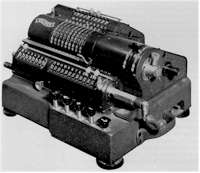 An electrified
version, the EMKD, was manufactured around 1929
and this model had independent carriage shift keys.
Similar mechanical machines were still available as late
as the early 1970’s and were designated the WSR
110 and WSR 160. One assumes the number
designated the capacity. An electrified
version, the EMKD, was manufactured around 1929
and this model had independent carriage shift keys.
Similar mechanical machines were still available as late
as the early 1970’s and were designated the WSR
110 and WSR 160. One assumes the number
designated the capacity. |
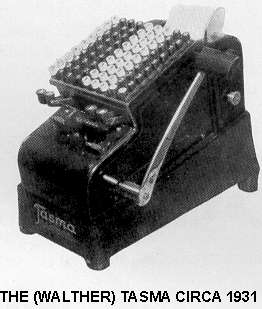 In 1931 the rather strange looking
machine on the left was added to the range. This machine
was designated the TASMA and worked as a print
out calculator. It appears to have sub total and grand
total keys as well as a clearance key. Each time an entry
was added to the keyboard the large crank was pulled
forward adding the information into the accumulators and
printing the keyboard data on to the paper roll. Prices
of such machines may be of interest to the readers
wishing to know them for historic purpose. The EMK
(Electric machine) with semi-automatic division was
around 850 Reichmark whereas the, EMKD model,
fully automatic division model sold for 950 Reichmark.
The least expensive Tasma listing machine sold
for 240 Reichmark and there were around seventeen models
in the range. Three models were electrically driven.
Little is reported about Walther during the years that
Europe was ravaged by war and one assumes, in the light
of how Governments work, that Walther, as a machine tool
company, would be forced to join the war effort in
manufacturing weapons. This is only an assumption on the
authors behalf, however, it is the likeliest scenario. In 1931 the rather strange looking
machine on the left was added to the range. This machine
was designated the TASMA and worked as a print
out calculator. It appears to have sub total and grand
total keys as well as a clearance key. Each time an entry
was added to the keyboard the large crank was pulled
forward adding the information into the accumulators and
printing the keyboard data on to the paper roll. Prices
of such machines may be of interest to the readers
wishing to know them for historic purpose. The EMK
(Electric machine) with semi-automatic division was
around 850 Reichmark whereas the, EMKD model,
fully automatic division model sold for 950 Reichmark.
The least expensive Tasma listing machine sold
for 240 Reichmark and there were around seventeen models
in the range. Three models were electrically driven.
Little is reported about Walther during the years that
Europe was ravaged by war and one assumes, in the light
of how Governments work, that Walther, as a machine tool
company, would be forced to join the war effort in
manufacturing weapons. This is only an assumption on the
authors behalf, however, it is the likeliest scenario. |
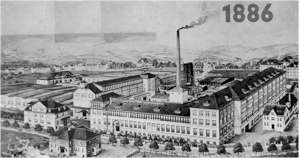 At the onset of
the war in 1939 the old factory, which Carl Walther
founded in Zella-Mahlis in the region of Thuringia
employed some 2000 people. By the end of the second world
war the factory was lost either because it was located in
the new state of East Germany or because it had been
bombed out of existence; information related to East
Germany is not easy to come by. Suffice to say a new home
was required. At first a team of Walther engineers worked
in makeshift workshops in the town of Heidenhelm. At the onset of
the war in 1939 the old factory, which Carl Walther
founded in Zella-Mahlis in the region of Thuringia
employed some 2000 people. By the end of the second world
war the factory was lost either because it was located in
the new state of East Germany or because it had been
bombed out of existence; information related to East
Germany is not easy to come by. Suffice to say a new home
was required. At first a team of Walther engineers worked
in makeshift workshops in the town of Heidenhelm.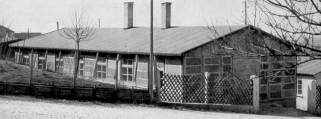 These workshops looked little better than
an army barracks platoon hut. Nevertheless, as a result
of their labours the Walther Company got ready to make
calculating machines again. New factories were built over
the next few years. First of all at Niederstotingen in
1948 manufacturing a new version of the RMKZ,
followed by factories at Königsbronn, Gerstetten, and
Ulm (1950). In a very short time the plants are in full
production and by 1947 were employing as many people as
the old plant was employing in 1939. In addition the
plants had the very latest in technology, new machine
tools, new presses and advanced techniques. It was not
very long before the Walther name was once again as
synonymous with quality equipment as it had been prior to
the war. New jobs created vacancies for new apprentices
and these were trained in the use of modern equipment
from an early age. Many hundreds of parts are required to
construct adding machines and these apprentices were
given the opportunity to learn from the ground up. These workshops looked little better than
an army barracks platoon hut. Nevertheless, as a result
of their labours the Walther Company got ready to make
calculating machines again. New factories were built over
the next few years. First of all at Niederstotingen in
1948 manufacturing a new version of the RMKZ,
followed by factories at Königsbronn, Gerstetten, and
Ulm (1950). In a very short time the plants are in full
production and by 1947 were employing as many people as
the old plant was employing in 1939. In addition the
plants had the very latest in technology, new machine
tools, new presses and advanced techniques. It was not
very long before the Walther name was once again as
synonymous with quality equipment as it had been prior to
the war. New jobs created vacancies for new apprentices
and these were trained in the use of modern equipment
from an early age. Many hundreds of parts are required to
construct adding machines and these apprentices were
given the opportunity to learn from the ground up. |
| Pride was engendered in the workforce and this was revealed in the design and quality of the machines. As the author was only involved with Walther Office equipment he has no knowledge of parallel projects although he believes the Ulm plant was dedicated to the manufacture of sporting guns. The fact such weapons were made is evidenced by the current Walther CP-88 CO2 Pistol (air pistol) which indicates the manufacture of such equipment continued. This does not interest us greatly and is merely added as a point of historic interest. Our interest is in the continuation of various mechanical calculating machines. Apart from newer versions of the old products the author knows of no new products until around 1952 when George Walther introduced a 220 cycle electronic adding machine ( the 101WS ? ) to the Hanover Fair. At this time the 220 cycles being the fastest machine available. The machine had a bulbous appearance in an, at the time considered fashionable, buff colour. The machine had an accumulator section that could be toggled to the front or rear of the machine to add or subtract as required. The numbers were entered through a ten or twelve digital keyboard, plus function keys (plus, minus, sub-total and grand total plus a reference key) in the case of Australian machines I seem to recall a ‘Whole Number Key’ that when down, jumped the pin box left to inhibit the racks normally used for 'sterling' operations. Numbers entered into the keyboard were stored in a pin box located under the keyboard and as each new digit was entered the pin box moved left one position until the complete number was entered. On pressing a function key the racks moved towards the rear of the machine until they were stopped by the pin box. At the same time the accumulator section toggled into the upper segment racks thus adding the corresponding number into the accumulator. Any carry overs dropped a secondary rack back one position and as the collector bail collected the mechanism to return it to normal the carries were added to the accumulator section. In printing to the paper the printing wheels were rotated into the position designated by the pin box and at the end of the operation the spring loaded wheel arms were released towards the platen putting an impression on the paper via a two colour ink ribbon. |
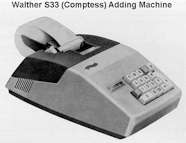 This
bulky machine was soon replaced by a rather neat version
called the Comptess (or S33). The new
‘Comptess’ was, in any case, a
delightful little piece of equipment in a two tone
plastic case and they were relatively inexpensive.
Excellent for the small business on limited funds. They
were a great selling item featuring a good sturdy
mechanism that performed almost flawlessly in the years I
worked on them. The S33 also had a sister
machine called the Multa 33 that multiplied
automatically. A heavy duty (sterling) machine called the
P12 was still available for those who liked good
solid machines. The possibility exists that the twelve in
the name indicated the least significant position on the
machine had a twelve tooth rack and twelve tooth pinions
for adding pence plus a ten shilling column (three rows).
The cross section drawing illustrates the general
concept. I may at some later date fill in some specific
details of its operational concepts. This basic concept
however provided the basis for many models including a
model capable of multiplication (called the Multa 32 and
introduced around 1959). A model capable of duplex
operation and its counter part a multiplying duplex
machine the Multa GT. A model capable of
division called the DIWA 32. Some models had a
shuttle carriage that enabled them to be used as airline
ticket and railway ticket writers. This
bulky machine was soon replaced by a rather neat version
called the Comptess (or S33). The new
‘Comptess’ was, in any case, a
delightful little piece of equipment in a two tone
plastic case and they were relatively inexpensive.
Excellent for the small business on limited funds. They
were a great selling item featuring a good sturdy
mechanism that performed almost flawlessly in the years I
worked on them. The S33 also had a sister
machine called the Multa 33 that multiplied
automatically. A heavy duty (sterling) machine called the
P12 was still available for those who liked good
solid machines. The possibility exists that the twelve in
the name indicated the least significant position on the
machine had a twelve tooth rack and twelve tooth pinions
for adding pence plus a ten shilling column (three rows).
The cross section drawing illustrates the general
concept. I may at some later date fill in some specific
details of its operational concepts. This basic concept
however provided the basis for many models including a
model capable of multiplication (called the Multa 32 and
introduced around 1959). A model capable of duplex
operation and its counter part a multiplying duplex
machine the Multa GT. A model capable of
division called the DIWA 32. Some models had a
shuttle carriage that enabled them to be used as airline
ticket and railway ticket writers.
|
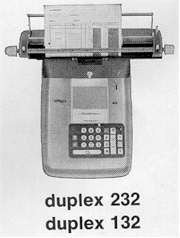 Others with duplex registers could be
programmed to work as small ledger machines producing
debit and credit dual column balance sheets. Others with duplex registers could be
programmed to work as small ledger machines producing
debit and credit dual column balance sheets. A rotating tabular rack with stop pins to locate the carriage was introduced and this allowed it to be rotated to one of four user selectable positions. As racks were available one assumes that many racks could be stocked for varying the operation to suit the job.
|
 The machines took on a squarish form as per
the illustration to the right. The Walther Company was
obviously very aware of this `writing on the wall’
as rapid changes were made to cater for the new era. The
first signs were drawings that incorporated electronic
gates in order, one assumes, to create the image of a
very up to date company. Electronic models of the Walther
started to be produced however the state of the art had
ever changing goal posts. Everything was moving very
quickly, some may argue too quickly. The machines took on a squarish form as per
the illustration to the right. The Walther Company was
obviously very aware of this `writing on the wall’
as rapid changes were made to cater for the new era. The
first signs were drawings that incorporated electronic
gates in order, one assumes, to create the image of a
very up to date company. Electronic models of the Walther
started to be produced however the state of the art had
ever changing goal posts. Everything was moving very
quickly, some may argue too quickly. |
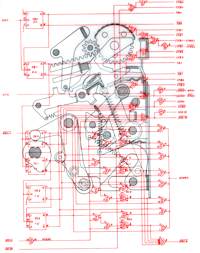 The author
continued on in the industry however track of the Walther
and the Company was lost around February of 1979. By that
time several electronic machines manufactured by Walther
were in full production but Companies like H.W. Egli (MADAS)
and Walther did not seem to fit in this new world. By the
mid eighties even electronic machines were being updated
almost as quickly as the schematics and drawings touched
the drawing board. The author
continued on in the industry however track of the Walther
and the Company was lost around February of 1979. By that
time several electronic machines manufactured by Walther
were in full production but Companies like H.W. Egli (MADAS)
and Walther did not seem to fit in this new world. By the
mid eighties even electronic machines were being updated
almost as quickly as the schematics and drawings touched
the drawing board.
|
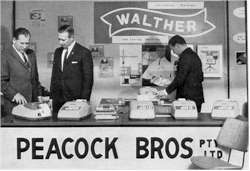 This report covers memories of only a small
area of a very large company. The recollections cover
only the mechanical calculator aspects of Walther.
Details and knowledge were gained from an association of
some twenty years as service manager of Peacock Bros of
Melbourne, Australia. The information is provided in
response to questions received via the Internet. Every
endeavour has been made to keep the recollections
accurate. The information is to be considered available
for educational purpose however, it may not be used for
profit or gain. Logos and business names are the
properties of the respective companies. This report covers memories of only a small
area of a very large company. The recollections cover
only the mechanical calculator aspects of Walther.
Details and knowledge were gained from an association of
some twenty years as service manager of Peacock Bros of
Melbourne, Australia. The information is provided in
response to questions received via the Internet. Every
endeavour has been made to keep the recollections
accurate. The information is to be considered available
for educational purpose however, it may not be used for
profit or gain. Logos and business names are the
properties of the respective companies. |
| Copyright © Ray Mackay. December 1997 All rights reserved |